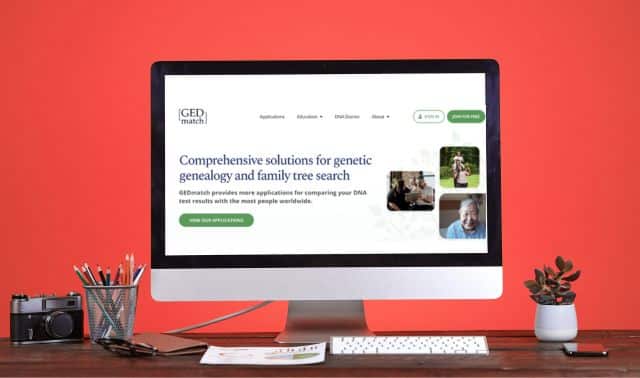Sign up for the Family Tree Newsletter! Plus, you’ll receive our 10 Essential Genealogy Research Forms PDF as a special thank you.
Get Your Free Genealogy Forms
"*" indicates required fields

The name change at Ellis Island. The American Indian “princess.” The unbreakable brick wall. Every genealogist has a mystery lurking within his or her family tree. Often the subject of years of persistent research, the mystery is pulled out of dusty files and re-examined from time to time, in hopes that a new database or new clue will finally reveal the answer. This is an incredible age for genealogists with unsolved mysteries. The advent of online access to old records has revolutionized genealogy and broken through thousands of brick walls. Yet some mysteries fail to yield their secrets despite all the tools the modern genealogist has at his disposal.
Genetic genealogy is another valuable tool that should be in your toolbox. Answers to family mysteries often hide in our very DNA. Genetic genealogy tests allow you to uncover relationships and connections that have long been forgotten or, sometimes, were intentionally concealed. Since these tests became available almost 15 years ago, many thousands of people have swabbed or spit (the most common methods for obtaining DNA samples). They’ve learned about their ancient origins, found genetic cousins and solved genealogical mysteries. Their DNA success are intriguing and may well help you find your own. How can you replicate their results?
Choosing the proper DNA test to probe a particular question can be a daunting task. Should you order a Y-DNA, mtDNA or autosomal DNA test, or some combination? When you get the results back, how do you apply them to your family tree or mystery?
To answer these questions, we’ll examine four real-life mysteries that everyday genealogists have investigated, and sometimes even solved, using DNA. (We changed some of the names for privacy reasons.) You’ll learn not only which tests will shed light on which types of mysteries, but also how to use DNA testing results to get the answers you’re looking for.
DNA Success #1: The Mystery of the Adopted Father
Shortly after her father’s death, Linda Spanos was shocked to learn he’d been adopted as an infant. Even her father likely didn’t know he’d been adopted. His wife, Linda’s mother, had accidentally discovered the truth decades ago and kept the secret to herself. Intensely curious about their biological roots, Linda and her siblings launched a two-decade search that would lead them through a roller coaster of twists and turns before DNA testing finally revealed an answer.
The Test
Linda’s brother agreed to take a Y-DNA test in hopes of learning their father’s biological surname. A Y-DNA test examines markers on the Y chromosome, a piece of DNA that’s only found in males and which is passed down only from father to son—usually, along with a surname. Therefore, Y-DNA testing can examine the relatedness of men with the same or similar surname. Male adoptees use Y-DNA testing so they can search large DNA databases for a match, thereby giving them a clue as to their own biological surname.
The Verdict
Linda’s brother had a relatively close match with someone of the surname Mayer. Through research in historical records, Linda and her family found several possible candidates of that surname who lived in the right place at the right time to be her biological grandfather. A short time later, though, an even closer match appeared in the database with the similar surname Meyer, which the match said had been changed from the original Meier. This close match shared a wealth of genealogical information, including the fact that three of his male relatives had immigrated to the United States and lived within a reasonable distance of Linda’s biological grandmother, thus making all three excellent candidates for the biological grandfather.
Next Steps
Although the Y-DNA test identified a possible surname, it couldn’t identify which Meier relative was Linda’s biological grandfather. To solve this mystery, the family turned to autosomal DNA testing. This type of test, which both men and women can take, examines thousands of locations throughout the DNA and compares them to the DNA of everyone else in the testing database in order to identify the test-taker’s genetic cousins.
To determine which of the three candidates was most closely related to Linda’s family and therefore the most likely biological grandfather, Linda’s brother and the descendants of each candidate took autosomal DNA tests. (Linda could have taken the autosomal test instead of her brother, but the testing company already had her brother’s DNA sample.) The results showed that although all three men were related to the family, one man in particular was much more closely related. His ancestor is likely Linda’s grandfather.
Lessons Learned
When looking for an adopted male’s possible biological surname, Y-DNA is a great way to start. While that will often reveal possibilities, other types of DNA testing, particularly autosomal DNA, may be needed to confirm a match. Sometimes it takes more than one type of DNA to solve a mystery.
DNA Success #2: The Mystery of the Inconclusive Records
At the Phillips DNA Project, Ron Phillips writes about his quest to determine whether the Rev. George Phillips of Watertown, Mass., is his paternal ancestor. Several sources suggest that the father of his most-distant known Phillips ancestor, Theophilus, was Zerobabel Phillips. Zerobabel was the first son of the Rev. George Phillips with his second wife, Elizabeth. But those sources don’t give any verifiable evidence, and other sources suggest that Zerobabel had no offspring.
The Test
The Rev. George Phillips would have passed his DNA to his sons, who passed it to their sons, and so on. If he is Ron Phillips’ ancestor, the two should have matching Y-DNA—so a Y-DNA test could answer this mystery. Of course the Rev. George Phillips is long dead, so Ron Phillips first had to find a known male-line descendant of the reverend to establish his Y-DNA signature. That took considerable research, but eventually two descendants of the Rev. George Phillips with well-researched pedigrees underwent testing. Their results could be compared to each other as well as to Ron Phillips’ Y-DNA test results.
The Verdict
The two identified descendants of the Rev. George Phillips indeed matched one another, suggesting that the reverend’s Y-DNA profile had been successfully identified. Ron Phillips then compared his own Y-DNA results to the identified signature to determine whether he was also a match. The results showed that Ron Phillips’ Y-DNA was in fact not a match to the signature of the Rev. George Phillips. How is this a DNA success? This suggests that Theophilus Phillips was likely not the son of Zerobabel Phillips, and thus that Ron was not a descendant of the Rev. George Phillips.
Next Steps
The results of Y-DNA testing weren’t a perfect resolution to this mystery: Ron Phillips still doesn’t know who Theophilus’ father was. But the negative outcome will save Ron’s family all the time they might have otherwise wasted trying to prove a connection to the Rev. George Phillips. Perhaps someone else with a Y-DNA signature matching Ron’s will take a Y-DNA test, turn up in a results database, and reveal new genealogical information.
Lessons Learned
Even negative DNA test results can be revealing. Evidence that you don’t match someone can save you from years spent on the wrong research. Further, it can force you to pursue other avenues you wouldn’t otherwise have considered.
DNA Success #3: The Mystery of the American Indian Ancestor
Sometimes, DNA testing creates a mystery instead of solving one. In 2012, Anne Marie Hadaway agreed to take a mitochondrial DNA (mtDNA) test her cousin had purchased. Because women pass mtDNA to their children, and mutations are rare, the test would examine Anne Marie’s mother’s mother’s mother’s (and so on) line back to ancient times. Although not then a genealogist, Anne Marie thought it would be interesting to learn about the ancient origins of her maternal line. But when her test results came back, Anne Marie was surprised that her mitochondrial DNA belonged to a distinctly American Indian haplogroup labeled A2.
The Test
Because Anne Marie had no knowledge of American Indian roots in her maternal line, she wondered if she had any other Native American DNA, and how much. To examine this, Anne Marie took an autosomal DNA test, which can be used to identify the geographical origins of DNA.
The Verdict
The company that performed Anne Marie’s test estimated that approximately 3 percent of her DNA was American Indian in origin. This suggests that her closest Indian ancestor was recent enough to have left a signature in her autosomal DNA.
Next Steps
Bitten by the genealogy bug, Anne Marie recruited her mother to take an autosomal DNA test to learn more about their Native American roots. Those test results revealed that Anne Marie’s American Indian autosomal DNA was inherited from her mother, just as her mtDNA was. The two autosomal tests also identified several genetic cousins who have matching mtDNA in addition to autosomal DNA. Anne Marie is now researching her maternal line in genealogical records, hoping to identify her mysterious Indian ancestor.
Lessons Learned
It can be challenging to narrow down which ancestor you and a genetic match share, or which family line a particular ancestor is in, using autosomal DNA alone. That task may be easier with a Y-DNA or an mtDNA test. Anne Marie’s American Indian mtDNA points her to the line she should research to identify her American Indian ancestor.
DNA Success #4: The Mystery of the Great-Grandmother’s Parents
Helen Johnson was born March 2, 1889, in upstate New York. Although her birth was recorded in one of the earliest New York state birth certificates, her father was listed as “not known.” Her mother, although named, remains a mystery to Helen’s descendants who’ve tried to research her. No fewer than three families took in Helen before she turned 13, and she married into the last family to adopt her. Although she lived a long and content life, she died without knowing who her biological parents were.
The Tests
Helen died long before the advent of genetic genealogy. The only DNA available for testing would have to come from one or more of her many descendants. Helen had two children, a son and a daughter, each of whom had at least one child. Helen’s daughter inherited her mother’s mtDNA and passed it on to her son. The simplest testing approach was for this grandson to take an mtDNA test in hopes of finding a match, but none have been found.
Next, the family turned to autosomal DNA. Each of Helen’s children inherited half of their autosomal DNA from their mother. Each of their children share approximately 25 percent of their DNA with their grandmother. Two male grandchildren, one from each of Helen’s children, underwent autosomal DNA testing to find genetic relatives that match both of them. A person matching both grandsons would suggest all three are related through either Helen or her husband. If the family tested just one grandchild, or even two grandchildren who are siblings, a match might be related through the grandchild’s other parent and not through Helen’s line.
The Verdict
Although Helen’s grandsons share slightly less DNA than the 12.5 percent that first cousins typically share, they’re well within the range of first cousins. The testing company’s database contains numerous matches to both men, including some relatively close matches estimated to be third cousins.
Next Steps
The two cousins have so far determined that one of their matches is related through Helen’s husband’s side. They’re continuing to work with their genetic relatives and conduct genealogical research to find candidates for Helen’s biological parents. Finding a common ancestor with genetic matches can be challenging enough, but this family is trying to find a common ancestor based only on a time and place, without the benefit of any surnames. They hope to find enough overlap in the matches’ family trees to narrow down who Helen’s parents might be. In addition, a match to the initial mtDNA test still might turn up.
Lessons Learned
Although potentially powerful, autosomal DNA testing rarely provides an immediate answer. Traditional genealogical research is usually needed to find a common ancestor with an autosomal DNA match.
One of the most important points these examples emphasize is that DNA testing alone rarely operates as a bulldozer for a brick wall. Instead, DNA testing complements and builds on extensive genealogical research to examine a mystery or provide a definitive answer.
An important and often overlooked genetic genealogy strategy is using more than one type of DNA test to examine a family mystery. For example, a Y-DNA test may suggest a surname, as it did for Linda Spanos’ family, and following up with an autosomal DNA test can narrow down a list of candidates. Then research in genealogical records might put one candidate in the right place and time. When you’re considering using DNA to solve a research problem, first make a plan of attack: Which types of DNA testing can you use to examine your particular mystery? Who can you ask to take the DNA tests you’ve identified? How will your plan change if the results are inconclusive, or if they refute your original hypothesis? What additional genealogical research can you do before and/or after testing to help you find the right answer? When you’ve answered or at least considered these questions, you’re ready to begin your genetic genealogy adventure. What mysteries can your DNA solve?
Testing, Testing
Dozens of genetic genealogy testing companies offer a broad range of Y-DNA, mtDNA and autosomal tests to help you find relatives and/or discover your ethnic origins. You can see a list of testing companies, along with the types of tests each one offers, at isogg.org. To examine the types of genealogical questions described here, I recommend working with the tests available from these companies:
- 23andMe: autosomal test
- AncestryDNA: autosomal test
- Family Tree DNA: Y-DNA, mtDNA and autosomal (called Family Finder) tests •
- MyHeritage DNA: autosomal test
Gene Therapy
Get help planning your genetic genealogy testing strategy and interpreting your test results with these websites:
- DNAeXplained—Genetic Genealogy blog
- Family Tree DNA Surname Projects
- The Genetic Genealogist blog
- International Society of Genetic Genealogy
- Online Journal of Genetics and Genealogy
- Your Genetic Genealogist blog
Tip: If you’ve taken a DNA test, especially with 23andMe or Family Tree DNA, you’ll find tools to help you analyze your results at DNAGedcom and Gedmatch.
Tip: When pursuing genetic genealogy, be sure to understand the limitations and benefits of each type of test. You’ll save yourself considerable time and money before and after testing.
A version of this article originally appeared in the July/August 2014 issue of Family Tree Magazine




